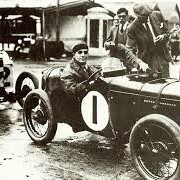Sammy Davis

Sydney Charles Houghton “Sammy” Davis (9 January 1887, London – 9 January 1981, Guildford) was a British racing motorist, journalist and clubman.
While best known as Sports Editor of The Autocar, writing under the pen-name Casque (French for helmet), Davis also competed in many forms of motor racing in the 1920s. He won many awards in the popular trials competitions of the day.
As Sports Editor, Davis aided his prewar motorcycling associate, W. O. Bentley, in starting his company. In 1921, Davis was invited by S. F. Edge to join Edge’s Brooklands AC racing team, in between magazine deadlines, while in 1922 he was part of Aston Martin’s effort to break no less than 32 world and class records at Weybridge. Davis became a one of the famous Bentley Boys of the late 1920s. He won the 24 Hours of Le Mans outright in 1927. Partnered with Dr. Benjafield, they covered 1,472.527 miles at an average speed of 61.354 mph (98.740 km/h). Motor Sport reported: “The victory, in spite of its accident of the crippled 3-litre Bentley driven by J.D. Benjafield and S.C.H. Davis, will always remain an epic, and even if the competition was not as keen as in the past, it is great thing to have won a race with a car which was damaged in the early part of the event.” In 1928 he finished ninth overall at Le Mans on a 1½-litre front-wheel-drive Alvis.
In 1925, Davis finished second at Le Mans with co-driver Jean Chassagne in a 3-litre twin cam Sunbeam, covering 1,343.2 mi (2,161.7 km), some 45 mi (72 km) behind the winner. Davis piloted a 3-litre Bentley at Le Mans in 1926, crashing in an attempt to take the lead only twenty minutes from the flag. On 7 May 1927, Davis finished second in the Essex Car Club Six Hour race at Brooklands on an Alvis 12/50.[9] At Le Mans that year, Davis became the stuff of racing legend when, at the wheel of the 3-litre Bentley “Old Number Seven”, he skidded into a pileup at White House and saw the chassis twist, but nevertheless went on to win. Davis would enter the 1928 Le Mans, coming ninth at the wheel of a front wheel drive 1,500 cc (92 cu in) Alvis shared with Urquhart-Dykes. He would also come second at the 1929 Saorstat Cup, Phoenix Park, and at the Brooklands Double-Twelve (24 hours in two shifts, because the track was prohibited from holding racing at night) and 500 mi (800 km).
In 1929, Davis finished second overall, and class winner, in the Brooklands Double Twelve on a 4,398 c.c. Bentley. He finished second again in 1930 on a 5,597 c.c. Bentley. At Le Mans in 1930 he met with misfortune, when his goggles were shattered by a stone, forcing his retirement; there were concerns he might be blinded. On 4 October 1930, Davis was partnered with the Earl of March in an Austin Seven and they won the B.R.D.C. 500-mile race at Brooklands outright, at an average speed of 83.41 mph (134.24 km/h). Also at Brooklands that year, Davis set several Class H records in the Seven, including a flying kilometre of 89.08 mph (143.36 km/h). (For the kilometre, his co-driver was Charles Goodacre.)[14] His efforts for the year earned him a BRDC Gold Star. He also entered a Daimler Double-Six sleeve-valve V12 at Monte Carlo.
He had a spectacular accident in a low-chassis[14] Invicta S-type at Brooklands in 1931, skidding into a telegraph pole. In 1933 he finished ninth at Le Mans in an Aston Martin.
At the 1935 Tourist Trophy, Davis’ Singer Nine crashed due to a broken steering ball-joint. He hit Norman Black’s Nine, which had crashed for the same reason at the same place. Despite the severity of the crash, Davis was unhurt.
On 15 April 1937, Davis drove a Frazer-Nash BMW round Brooklands, covering more than 100 mi (160 km) in an hour, at an average speed of 102.22 mph (164.51 km/h)[16] The same year, his Wolseley earned “a special award for being the best-equipped car to finish”.
